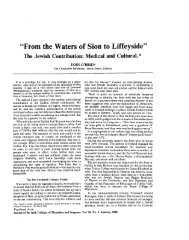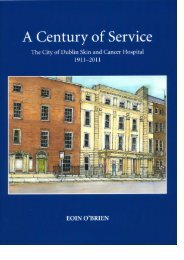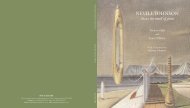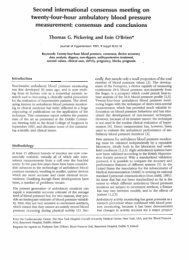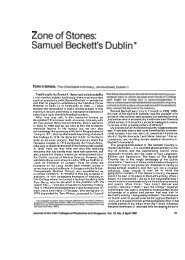Twenty-four-hour ambulatory blood pressure in ... - Eoin O'Brien
Twenty-four-hour ambulatory blood pressure in ... - Eoin O'Brien
Twenty-four-hour ambulatory blood pressure in ... - Eoin O'Brien
You also want an ePaper? Increase the reach of your titles
YUMPU automatically turns print PDFs into web optimized ePapers that Google loves.
1642 Journal of Hypertension 2003, Vol 21 No 9<br />
Methods<br />
The study protocol was approved by Beaumont Hospital<br />
Research Ethics Committee. Subjects were assessed<br />
by a research nurse or a physician, at the study centre,<br />
the Blood Pressure Unit, Beaumont Hospital. Subjects<br />
were recruited from local active-retirement associations,<br />
the local community and a general practitioner’s practice<br />
register. All were liv<strong>in</strong>g <strong>in</strong>dependently <strong>in</strong> the<br />
community. Subjects were healthy as def<strong>in</strong>ed by be<strong>in</strong>g<br />
ambulant, self-car<strong>in</strong>g, not limited by cardiovascular<br />
disease or tak<strong>in</strong>g vasoactive medication, and not limited<br />
by any other major illness. Additional health status<br />
details were obta<strong>in</strong>ed by questionnaire. A history of the<br />
follow<strong>in</strong>g conditions (as diagnosed by a physician) was<br />
sought: hypertension, heart attack, ang<strong>in</strong>a, stroke, transient<br />
ischaemic attack, cardiac failure, or peripheral<br />
arterial disease. Current drug treatment was also recorded.<br />
A history of hypertension was permitted if the<br />
subject was not on treatment. Weight, height and mid<br />
upper-arm circumference were measured. Subjects tak<strong>in</strong>g<br />
medication affect<strong>in</strong>g <strong>blood</strong> <strong>pressure</strong> were excluded.<br />
There were no <strong>blood</strong> <strong>pressure</strong> eligibility criteria, subjects<br />
found to be hypertensive were <strong>in</strong>cluded if they<br />
were not tak<strong>in</strong>g medication affect<strong>in</strong>g BP. BP was measured<br />
twice <strong>in</strong> the sitt<strong>in</strong>g position us<strong>in</strong>g a mercury<br />
sphygmomanometer, accord<strong>in</strong>g to the recommendations<br />
of the British Hypertension Society [19]. The mean of<br />
these two measurements was used as the CBP. The<br />
SpaceLabs 90207 (SpaceLabs, Redmond, Wash<strong>in</strong>gton,<br />
USA) <strong>ambulatory</strong> <strong>blood</strong> <strong>pressure</strong> monitor was then<br />
fitted to the non-dom<strong>in</strong>ant arm, us<strong>in</strong>g an appropriately<br />
sized cuff and programmed to record <strong>blood</strong> <strong>pressure</strong><br />
every 30 m<strong>in</strong> throughout the 24-h period, commenc<strong>in</strong>g<br />
between 0900 and 1200 h. This device has been<br />
previously validated [20]. Subjects were <strong>in</strong>structed to<br />
cont<strong>in</strong>ue normal daily activities, but to rest their arm at<br />
the times of BP measurement. Diaries were supplied,<br />
and subjects were asked to record activities, <strong>in</strong>clud<strong>in</strong>g<br />
bedtime and meal times.<br />
Data analysis<br />
<strong>Twenty</strong>-<strong>four</strong>-<strong>hour</strong> ABP record<strong>in</strong>gs were unedited. Daytime<br />
was def<strong>in</strong>ed as 0900–2100 h and night-time as<br />
0100–0600 h, and mean daytime BP and night-time BP<br />
levels were calculated for each <strong>in</strong>dividual. Record<strong>in</strong>gs<br />
with less than a m<strong>in</strong>imum of 16 daytime, six nighttime,<br />
or a total of 30 measurements were rejected. In<br />
calculat<strong>in</strong>g <strong>hour</strong>ly means, each BP measurement is<br />
taken to represent the measurements at each m<strong>in</strong>ute<br />
from 15 m<strong>in</strong> before to 15 m<strong>in</strong> after the actual read<strong>in</strong>g.<br />
The <strong>hour</strong>ly mean is the average of all representative<br />
read<strong>in</strong>gs occurr<strong>in</strong>g from the start of an <strong>hour</strong> to 59 m<strong>in</strong><br />
past the <strong>hour</strong>. This calculation is well def<strong>in</strong>ed, as an<br />
alteration <strong>in</strong> time of a particular read<strong>in</strong>g will at most<br />
have a marg<strong>in</strong>al effect on the average of two representative<br />
<strong>hour</strong>s. Data normality was checked us<strong>in</strong>g the<br />
Kolmogorov–Smirnov test. Normally distributed vari-<br />
ables were compared us<strong>in</strong>g Students t test or analysis of<br />
variance. The chi-square test was used to analyse<br />
categorical data and Pearson’s coefficient was used for<br />
correlation analysis. A value of P , 0.05 was considered<br />
significant for all tests. For analysis, the SPSS software<br />
package was used (SPSS Inc., Chicago, Ill<strong>in</strong>ois, USA).<br />
Results<br />
Subject characteristics<br />
A total of 156 subjects had complete 24-h ABPM<br />
record<strong>in</strong>gs, age range 60–102 years. There were 75<br />
‘young elderly’ aged 60–79 years (39 men, 36 women)<br />
and 81 ‘old elderly’ aged 80 years and older (37 men,<br />
44 women). Subject characteristics are presented <strong>in</strong><br />
Table 1. Ten subjects, five ‘young elderly’ and five ‘old<br />
elderly’, reported a history of cardiovascular disease.<br />
Age, subject characteristics and BP levels were similar<br />
<strong>in</strong> these 10 subjects compared with subjects without a<br />
history of cardiovascular disease (data not shown).<br />
<strong>Twenty</strong>-two subjects reported be<strong>in</strong>g told <strong>in</strong> the past<br />
that their BP was elevated, <strong>four</strong> of whom had a history<br />
of cardiovascular disease.<br />
BP levels<br />
There was a positive association between age and<br />
systolic <strong>blood</strong> <strong>pressure</strong> (SBP). Correlation coefficients<br />
between age and SBP were 0.31, 0.25 and 0.31,<br />
respectively, for conventional SBP, daytime SBP and<br />
night-time SBP (P , 0.01 for all). There was no correlation<br />
between age and diastolic <strong>blood</strong> <strong>pressure</strong> (DBP),<br />
neither CBP nor <strong>ambulatory</strong> DBP. CBP and ABP<br />
results are presented <strong>in</strong> Table 1. Gender did not<br />
<strong>in</strong>fluence BP levels. Mean CBP, daytime BP and nighttime<br />
BP levels <strong>in</strong> the ‘young elderly’ were 149/81, 138/<br />
82 and 119/69 mmHg, respectively, and <strong>in</strong> the ‘old<br />
elderly’ BP levels were 162/82, 147/83, and 133/<br />
71 mmHg, respectively (P , 0.001, for SBP variables).<br />
There were no significant differences <strong>in</strong> conventional<br />
or <strong>ambulatory</strong> DBP between ‘young’ and ‘old’ elderly<br />
subjects. CBP and daytime BP were correlated, coefficients<br />
0.69/0.51 for SBP/DBP, respectively (P , 0.01<br />
for both).<br />
<strong>Twenty</strong>-two subjects (14%) reported a history of hypertension<br />
but were not tak<strong>in</strong>g treatment. These 22<br />
subjects were of similar age to the 134 subjects who did<br />
not report a history of hypertension, but had significantly<br />
higher BP levels, both CBP and ABP (Table 2).<br />
Age-related differences <strong>in</strong> SBP between ‘young elderly’<br />
and ‘old elderly’ subjects persisted, and rema<strong>in</strong>ed significant,<br />
when subjects with a history of hypertension<br />
were excluded.<br />
<strong>Twenty</strong>-<strong>four</strong>-<strong>hour</strong> BP profile<br />
<strong>Twenty</strong>-<strong>four</strong>-<strong>hour</strong> BP and heart rate profiles are shown<br />
<strong>in</strong> Figures 1 and 2. In addition to the nocturnal dip <strong>in</strong><br />
BP, a mid-afternoon dip <strong>in</strong> <strong>blood</strong> <strong>pressure</strong> with a nadir<br />
Copyright © Lipp<strong>in</strong>cott Williams & Wilk<strong>in</strong>s. Unauthorized reproduction of this article is prohibited.




